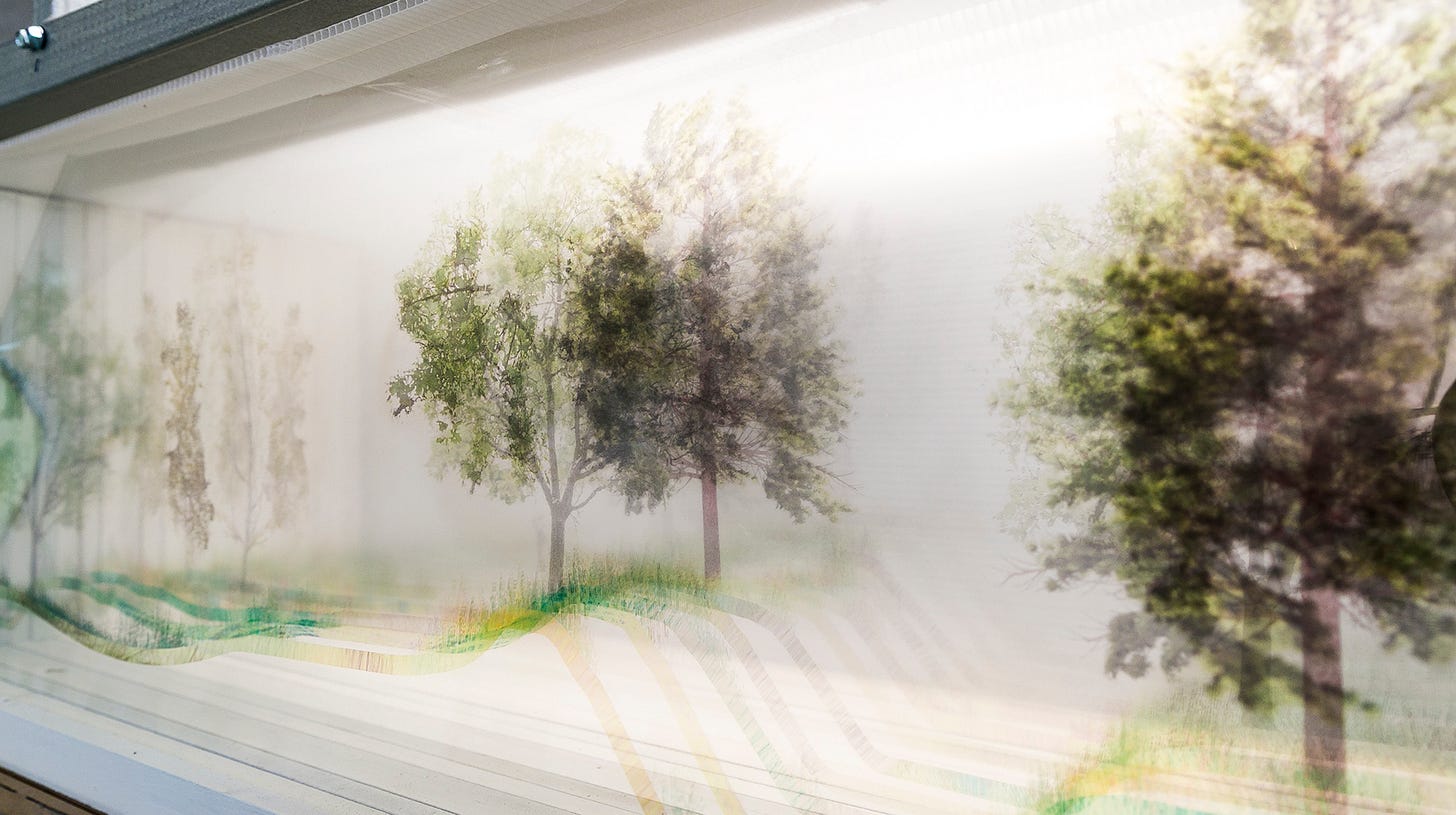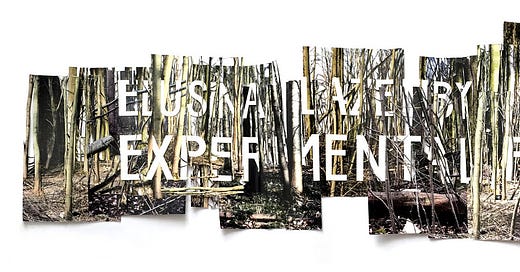From "THE FLAT FILES" - the deep cuts from our archive. The Elusina Lazenby Experimental Forest centers on the multiple layers and lenses through which we interpret and represent landscapes. The installation takes the form of, and plays with, the conceit of the landscape interpretive center. Commissioned in 2016 for the 100th anniversary of The Ohio State University's landscape program, it is named in honor of Elusina Lazenby, the first woman to receive an MLA from Ohio State in 1926.
The installation draws threads from the landscape dioramas at the Fischer Museum at the Harvard Forest depicting changes in New England forests over four centuries, the SLU Alnarp Landscape laboratory, founded by Roland Gustavsson and Anders Busse Nielsen, and the critical frameworks of the Center for Land Use Interpretation. Elusina critiques the many cliches swirling around landscape: didactic interpretive centers, banal architecture-as-landscape projects, and overly earnest works of eco-art, including the dreaded exhibitions of “plants in the gallery” where potted specimens are left to whither under the gaze of bored museum attendants.
The installation’s nested elements shuttle between layers of real and imagined. They include an imagined Elusina Lazenby Experimental Forest (ELEF), nearby at Ohio State’s Waterman Farm, the wall text of the exhibition, The Elusina Lazenby Experimental Forest Interpretive Center built within Knowlton Hall’s Barnvard Gallery, the dioramas and site models representing the experimental forest plots, and a group of interpreters. These trained volunteers interpret the exhibition and offer to accompany groups on tours of ELEF.

The installation critiques the many cliches swirling around landscape: didactic interpretive centers, banal architecture-as-landscape projects, and overly earnest works of eco-art, including the dreaded exhibitions of “plants in the gallery” where potted specimens are left to whither under the gaze of bored museum attendants.
The unfinished steel stud framework of the Elusina Lazenby Experimental Forest Interpretive Center intersects the Banvard Gallery at a 45-degree angle, implying the continuation of the interpretive center beyond the gallery walls. The construction suggests both a work-in-progress of architectural construction, while metaphorically, it represents a framework for the open-ended process of landscape interpretation. The open steel studs create a forest "room" and a support structure for the forest dioramas. The open framing allows one to see past the dioramas to the structural steel mullions and glazing of Knowlton Hall and beyond to the forest grove, designed by landscape architecture firm Michael Van Valkenburgh and Associates.

The dioramas oscillate through layers of interpretation. Each diorama represents an interpretation of a forest plot at the Experimental Forest. Each forest plot interprets a forest as described or depicted in different cultural expressions, from literature to video games. A scaled plan, section, and project description of the plot at the Experimental Forest accompany each diorama in the installation.



Postscript: Deadpan
The first loop of interpretive recursion in Elusina was the wall text. Exhibition wall texts are assumed to be “true” - a deadpan description and interpretation of the exhibition. Elusina levered the convention of the wall text to create a projective fiction: that there is an experimental forest on The Ohio State University campus at Waterman Farm, and students and faculty are developing test plots there. It read:
This exhibition displays work related to the Elusina Lazenby Experimental Forest at Ohio State’s Waterman Agriculture and Natural Resources Laboratory.
The Elusina Lazenby Experimental Forest is located at The Ohio State University's Waterman Agriculture and Natural Resources Laboratory. It operates as a living laboratory for testing the ecological and aesthetic qualities of forest gardens. The site work honors the legacy of Elusina Lazenby, the first woman to receive an MA in Landscape Architecture from The Ohio State University in 1926.
The forest gardens, as depicted in the dioramas in the interpretive center, are conceptualized, designed, installed, and maintained by Knowlton School students and faculty.
Yet, there was no experimental forest at Waterman Farm in 2016. The wall text served as a scaffold to imagine an experimental landscape laboratory's possibilities and pedagogical potentials at Knowlton School.
2023: The Elusina Lazenby Forest gets real
Today, Knowlton School’s landscape program features several actual test plots at Waterman Farm: Scarlet Jungles by Associate Professor Paula Meijerink; Meadow Lines by Present Practice (Katherine Jenkins and Parker Sutton) while conceptual works are ongoing, such as Glitching Waterman by Forbes Forbes Lipschitz.
On Scarlet Jungles:
An experimental urban forest, Scarlet Jungles was established at Ohio State Waterman Farm in August 2018. This autumn, the space also served as the classroom for landscape architecture students in the Scarlet Jungles seminar. Returning in the spring, seminar students planted sycamore, swamp white oak, hickory, and persimmon bare-root seedlings as part of the ongoing project that examines forest design through planting, documentation, and speculative projection.
On Meadow Lines:
Meadow Lines is an ongoing meadow restoration project that uses geospatial data produced by walking to generate scripts for design intervention.
Located on a one-acre public test site at Waterman Agricultural and Natural Resources Laboratory in Columbus, Ohio, Meadow Lines has transformed an industrial soybean field into a biodiverse prairie by mapping site walks across growing seasons and climatic conditions, analyzing their patterns and responding with maintenance decisions.
Elusina and its complementary 2016 symposium, “This is a Test,” heralded new directions in field-based landscape research in practice and pedagogy. These include Test Plot at the University of Southern California (Landscape Justice Initiative, Jen Toy, and Terremoto); The Mary Olive Thomas Experimental Forest at Auburn University (Emily Knox and David Hill); and The Milton Land Lab at the University of Virginia (Brian Davis).
Assistant Professor Sarah Cowles and the participants in the Sylviculture seminar produced the exhibition. The work is documented further on the Knowlton School website.
Sylviculture Studio Exhibition Team
Andrew Barringer • Candace Black-Housh • Clinton Calhoun • Alexandra Camponeschi • Anastasia Carrier Betsch • Sarah Cowles • Ryan Hillyer• Zachary Kapphahn • TJ McCready • Lauren McCrystal • Ryan McKee • Seth Oldham • Christa Radosavljevic • Jonathan Staker • Amy Kaye Taylor • Hallee Thompson • Anna Vagedes • John Wischmeyer • Hui Yuan
Special thanks to Michael Mercil for getting it.







